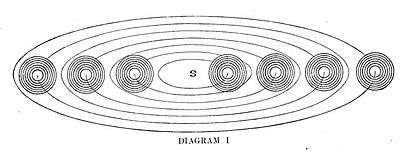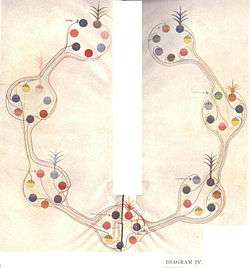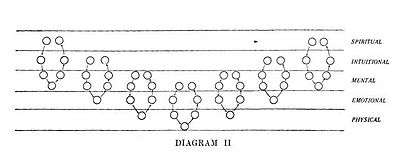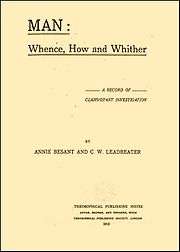Man: Whence, How and Whither, a Record of Clairvoyant Investigation
|
Title page to the 1st edition, 1913 | |
| Authors | Annie Besant, C. W. Leadbeater |
|---|---|
| Country | British India |
| Language | English |
| Subject | Theosophy |
| Publisher | Theosophical Publishing House |
Publication date | 1913 (1st edition) |
| Pages | 524 |
| OCLC | 871602 |
| Text | Man: Whence, How and Whither online |
Man: whence, how and whither, a record of clairvoyant investigation, published in 1913, is a theosophical book compiled by the second President of the Theosophical Society Annie Besant and by a member of the T. S. Charles Webster Leadbeater.[1] The book is a study on early times on a planetary chains, beginnings of early root races, early civilizations and empires, and past lives of men.[2]
Introduction

At the beginning the authors the book wrote that "metaphysicians, ancient and modern, declare that Past, Present, and Future are ever simultaneously existent in the divine Consciousness, and are only successive as they come into manifestation, i.e., under Time which is verily the succession of states of consciousness". Hence, when a mystic turn the soul away from earth and focuses his attention upon the spirit – the soul may approach the "Memory of Nature", the personification in the material world of the Thoughts of the Logos, the image, as it were, of His Mind. There resides the Past in ever-living records.[4]
The authors say that "they, having been taught the method of gaining touch, but being subject to the difficulties involved in their uncompleted evolution, have done their best to observe and transmit, but are fully conscious of the many weaknesses which mar their work. Occasional help has been given to them by the Elder Brethren."[5]
Explorations of past lives

Besant and Leadbeater speculate that "the total number of souls, or Monads,[7] making up humanity was sixty thousand million, the majority being out of incarnation at any given time".[8] Thus reincarnation[7][9] had been one of the doctrines of the Theosophical Society almost from its beginnings. The principal characters (so-called "star names" or pseudonyms) are identified in the following table.[10][11]
- Alcyone — Krishnamurti.[12]
- Fides — George Arundale.
- Herakles — Annie Besant.[13][14][15]
- Lomia — James Wedgwood.
- Phocea — W.Q. Judge.
- Polaris — B.P. Wadia.
- Selene — Jinarajadasa.
- Sirius — C.W. Leadbeater.[16]
- Siwa — Subba Row.
- Spica — Francesca Arundale.
- Ulysses — H.S. Olcott.[17]
- Vajra — H.P. Blavatsky.[18]
Leadbeater wrote later that "the two hundred and fifty characters to whom names have been assigned are supposed to be less than one tenth of the whole".[19]
Early root races
In Lemuria
In Chapter VII the authors describe in detail[20] remarkable Lemurian:
"In Lemuria there was some domestication of animals; the egg-headed Lemurian[21] was seen leading about a scaly monster, almost as unattractive as his master. Animals of all sorts were eaten raw – among some tribes human flesh was not despised – and creatures of the grade of our slugs, snails and worms, much larger than their degenerate descendants, were regarded with peculiar favor as toothsome morsels."[22][23]
In Atlantis
In Chapter IX the authors wrote about Atlantis that explosions of gas, floods and earthquakes razed Ruta and Daitya, the great islands, left from the cataclysm of 200,000 B.C., and only the island of Poseidonis remained, the last vestige of the once grand continent of the Atlantis. These islands were lost in 75,025 B.C., Poseidonis survived to 9,564 B.C., when it also was devoured by the ocean.[24]
The authors assert in Chapter X of the book:
"The immense growth of wealth and of luxury gradually undermined the most splendid civilization that the world has yet seen. Knowledge was prostituted to individual gain, and control over the powers of nature was turned from service to oppression. Hence Atlantis fell, despite the glory of its achievements and the might of its Empires."[25][26]
On the Moon chain

Blavatsky wrote in The Secret Doctrine that the Moon "plays the largest and most important part, as well in the formation of the Earth itself, as in the peopling thereof with human beings". The "Lunar Monads" or Pitris, the progenitors of man, become in reality man himself.[28]
In Chapter III the authors describe in detail how Sirius, Alcyone, Herakles and Mizar[29] achieved individualization[30] and left the animal kingdom while living as lunar monkey-creatures.[31] They were servants to a family of lunar men, the leaders of which are now the Masters M. and K.H.[32] Leadbeater wrote that "individualization from the animal kingdom usually takes place through association with the humanity of the period. Such examples of it as we occasionally see taking place round us at the present time will serve as instances for us." Some peculiar domestic animal, well treated by its human friends, is stimulated by its permanent contact with them up to the point where it breaks away from the group-soul to which it has previously belonged.[33] The authors wrote:
"One night there is an alarm; the hut is surrounded by savages, supported by their domesticated animals, fierce and strong, resembling furry lizards and crocodiles. The faithful guardians spring up around their master's hut and fight desperately in its defence; Mars comes out and drives back the assailants, using some weapons they do not possess; but, while he drives them backward, a lizard-like creature darts behind him into the hut, and catching up the child Surya[34] begins to carry him away. Sirius springs at him, bearing him down, and throws the child to Alcyone, who carries him back into the hut, while Sirius grapples with the lizard, and, after a desperate struggle, kills it, falling senseless, badly mangled, over its body. Meanwhile, a savage slips behind Mars and stabs at his back, but Herakles, with one leap, flings himself between his master and the weapon and receives the blow full on his breast, and falls, dying. The savages are now flying in all directions, and Mars, feeling the fall of some creature against his back, staggers, and, recovering himself, turns. He recognizes his faithful animal defender, bends over his dying servant, and places his head in his lap. The poor monkey lifts his eyes, full of intense devotion, to his master's face, and the act of service done, with passionate desire to save, calls down a stream of response from the Will aspect of the Monad in a fierce rush of power, and in the very moment of dying the monkey individualizes, and thus he dies – a man."[35]
The fruits of Evolution

The theosophical concept of Evolution suppose spiritual development of the Mankind will attain the fullness of the stature of Buddha, Christ, etc. of the prize of the high calling of God in Christianity.[7][37]
The authors the book proclaimed "when the Human Kingdom is traversed, and man stands on the threshold of His superhuman life, a liberated Spirit", seven paths open before Him for His choosing: He may enter into the blissful omniscience and omnipotence of Nirvana, with activities far beyond our knowing, to become, perchance, in some future world an Avatara, or godlike Incarnation; this is sometimes called, "taking the Dharmakaya vesture". He may enter on "the Spiritual Period" — a phrase including unknown meanings, among them probably that of "taking the Sambhogakaya vesture". He may become part of that treasure-house of spiritual forces on which the Agents of the Logos draw for Their work, "taking the Nirmanakaya vesture". He may remain a member of the Occult Hierarchy which rules and guards the world in which He has reached perfection. He may pass on to the next Chain, to aid in constructing its forms. He may enter the majestic Angel – Deva-Evolution. He may give Himself to the immediate service of the Logos, to be used by Him in any part of the Solar System, His Servant and Messenger, who lives but to carry out His will and do His work over the whole of the system which He controls.[38]
Criticism
Alvin Boyd Kuhn wrote in his Thesis that The Canadian Theosophist, a magazine published at Toronto, announced a series of articles in which "parallel passages from the writings of Mrs. Blavatsky and the Mahatma Letters on one side, and from the books of Mrs. Besant and Mr. Leadbeater, on the other (Man: whence, how and whither included), gave specific evidence bearing on the claims of perversion of the original theories by those whom they call Neo-Theosophists".[39][40]
John Prentice in article Clairvoyant Research criticized the book of the authors. He proclaimed that the material for the Peruvian lives in Man: whence, how and whither (chap. xi) had been lifted out of Garcilassode le Vega's Royal Commentaries on the Yuccas of Peru (written in 1609 and published in English translation in 1638, 1869 and 1871).[41]
Joseph Fussell wrote about "abnormal and preposterous claims" published by Besant and Leadbeater.[42][43]
Bailey stated that the book published at Adyar by Besant and Leadbeater was "psychic in his implications and impossible of verification". In A.A.B.'s Unfinished Autobiography she states that it proved to her the "untrustworthiness" of C.W. Leadbeater's writings.[44]
- "Books were being published at Adyar by Mr. Leadbeater that were psychic in their implications and impossible of verification, carrying a strong note of astralism. One of his major works, Man: Whence, How and Whither, was a book that proved to me the basic untrustworthiness of what he wrote. It is a book that outlines the future and the work of the Hierarchy of the future, and the curious and arresting thing to me was that the majority of the people slated to hold high office in the Hierarchy and in the future coming civilisation were all Mr. Leadbeater's personal friends. I knew some of these people—worthy, kind, and mediocre, none of them intellectual giants and most of them completely unimportant."[45]
See also
References
- ↑ Adyar: TPH. OCLC 871602, 524 p. illus. 25 cm. A last publication of the book is edition of the Altenmünster Jazzybee Verlag (2013).
- ↑ There were other collaborative authors clairvoyant works, Occult Chemistry (1908) and The Lives of Alcyone (1924).
- ↑ "At any one period of time only one of the rings in each Scheme will be active; each ring of each of these seven Schemes is composed of seven globes." // Man: whence, how and whither, chap. i.
- ↑ See also: Ramacharaka (1903), pp. 106-7; Tillett (1986), p. 985; Cerminara (1950); Cayce (1968); Todeschi (1998).
- ↑ Man: whence, how and whither, intro.
- ↑ See Man: whence, how and whither, Preliminaries (chap. i.)
- 1 2 3 See Трефилов (1994), p. 235.
- ↑ See Man: whence, how and whither, pp. iv-v.
- ↑ Fussell and Poutz (1914), Doctrines, Reincarnation (§3), p. 408.
- ↑ Drawn from the lists in Man: whence, how and whither, Foreword.
- ↑ Leadbeater talked in The Inner Life that, "about a hundred and fifty of those who are at present members of the Theosophical Society are the prominent characters in the drama which lies before the readers of The Theosophist." // Leadbeater (1912), section 4, part iv; see also a reminiscences by Ernest Wood (1947).
- ↑ Kuhn wrote that Alcyone is Krishnamurti's "true or cosmic name". // Kuhn (1930), p. 333.
- ↑ Curuppumullage Jinarajadasa claimed that Besant was Bruno. // Jinarajadasa (1938).
- ↑ Senkevich wrote that Annie Besant was Bruno, and Bruno earlier was Hipatia. // Сенкевич (2012), p. 459
- ↑ "Жизнь Джордано Бруно была воплощением Вел. Уч. Иллариона". // Рерих (1993), письмо от 11.08 1937.
- ↑ Jinarajadasa claimed that, "Mr. Leadbeater knew the details of his incarnation as a Greek in Athens". // Jinarajadasa (1941).
- ↑ About Olcott's past life see Man: whence, how and whither, chap. xxii.
- ↑ About Blavatsky's past life see The Hidden Life in Freemasonry by C.W. Leadbeater.
- ↑ Besant and Leadbeater (1924), Foreword.
- ↑ "Leadbeater wrote elaborate descriptions of these things in a style of simplicity and clearness", – claimed Kuhn. // Kuhn (1930), p. 328.
- ↑ Blavatsky stated that the Lemurian is "the first physical man which itself took place 18,000,000 years ago". // Blavatsky (1888), Vol. II, p. 46
- ↑ Godwin wrote, "Leadbeater regularly adopts an archly humorous tone when dealing with disgusting habits, ugly people, or lowly human types." // Godwin (2011), p. 99.
- ↑ Man: whence, how and whither, chap. vii.
- ↑ Man: whence, how and whither, chap.ix.
- ↑ Man: whence, how and whither, chap. x.
- ↑ Blavatsky claimed, "The civilization of the Atlanteans was greater even than that of the Egyptians. It is their degenerate descendants, the nation of Plato's Atlantis, which built the first Pyramids." // Blavatsky (1888), Vol. II, p. 429.
- ↑ See Трефилов (1994), p. 236
- ↑ Blavatsky (1888), vol. I, p. 180.
- ↑ Mizar — J. Nityananda (drawn from the lists in Man: whence, how and whither).
- ↑ "The divine life begins the evolution of consciousness, building for itself forms on the various planes, passing slowly through the elemental, mineral, vegetable, and animal kingdoms, and finally reaching self-consciousness and individualization, when it passes into the human stage." // Fussell and Poutz (1914), Doctrines. The Universe (§1), p. 407.
- ↑ The lunar Manvantara generated seven classes of the entities for the earthly Manvantara. // See Трефилов (1994), p. 234.
- ↑ M. — Mars, K.H. — Mercury (drawn from the lists in Man: whence, how and whither).
- ↑ Leadbeater (1912), section 6, part vi.
- ↑ "Surya – the Lord Maitreya, the present Bodhisattva, the Supreme Teacher of the world" (drawn from the lists in Man: whence, how and whither, Foreword)
- ↑ Man: whence, how and whither, chap.iii.
- ↑ "The vertical columns indicate the successive incarnations of the Chain; the horizontal divisions represent the various kingdoms of nature; the diagonal arrows are the successive waves of Evolution which have come forth from the Logos." // Leadbeater (1912), section 6, part iii.
- ↑ See Sellon and Weber (1992).
- ↑ Man: whence, how and whither.
- ↑ See Kuhn (1930), p.329
- ↑ Thomas wrote, "Many, many have doubtless been turned away from genuine Theosophy after being exposed to the obvious gibberish of 'Leadbeaterism' and not being aware of the difference." // Thomas (1924), notes.
- ↑ Prentice (1923).
- ↑ Fussell (1913).
- ↑ See also Tillett (1986), pp. 630-31.
- ↑ Мнение Е. Рерих менее дипломатично, "Особенно ужасна книга совместного творчества А. Безант и Ледбитера, заключающая в себе якобы жизни Великих Учителей и некоторых учеников, именно: г-жи Безант, Ледбитера... Я редко встречала что-либо равное по безвкусию, кощунственности и лживости." // Рерих (1993), из письма от 30.06.1934.
- ↑ Bailey (1951), chap. iv.
Sources
- Bailey, Alice (1951) The Unfinished Autobiography, ISBN 978-0-85330-124-0.
- Besant, A. and Leadbeater, C. (1924) The Lives of Alcyone: A Clairvoyant Investigation of the Lives Throughout the Ages of a Large Band of Servers, Adyar: TPH.
- Blavatsky, Helena P. (1888) The Secret Doctrine, Vol. I–II, London: The Theosophical Publishing Company.
- Blavatsky, Helena P. (1889) The Key to Theosophy, London: The Theosophical Publishing Company.
- Blavatsky, Helena P. (1892) The Theosophical Glossary, London: The Theosophical Publishing Company.
- Bruno, Giordano (1889) The Heroic Enthusiasts, trans. by L. Williams.
- Cayce, Edgar Evans (1968) Edgar Cayce on Atlantis, New York: Hawthorn, ISBN 0-312-96153-7.
- Cerminara, Gina (PhD) (1950) Many Mansions: The Edgar Cayce Story on Reincarnation. Penguin Group USA, ISBN 978-0-451-16817-7.
- Driscoll, John T. (1912) Theosophy // The Catholic Encyclopedia, vol. 14, p. 626. New York: Robert Appleton Company.
- Fussell, Joseph and Poutz, Marie (1914) Theosophy // The New Schaff-Herzog Encyclopedia of Religious Knowledge — pp. 407–10.
- Fussell, Joseph (1913) Some Reasons Why the Members of the Universal Brotherhood and Theosophical Society Do Not Endorse Mrs. Besant Nor the Society of Which She is President, Pt Loma.
- Godwin, Joscelyn (2011) Atlantis and the Cycles of Time: Prophecies, Traditions, and Occult Revelations. Inner Traditions, ISBN 978-1-59477-857-5.
- Heindel, Max (1909) The Rosicrucian Cosmo-Conception, Oceanside, California, U.S.A. ISBN 0-911274-34-0.
- Jinarajadasa, C. (1938) Occult Investigations — The Work of Annie Besant and C.W. Leadbeater, Adyar: TPH.
- Jinarajadasa, C. (1941) K.H. Letters to C.W. Leadbeater, Adyar: TPH.
- Kuhn, Alvin Boyd (1930) Theosophy: A Modern Revival of Ancient Wisdom. PhD Thesis. Whitefish, Montana: Kessinger Publishing, ISBN 978-1-56459-175-3.
- Leadbeater, Charles Webster (1899), Clairvoyance, London: The Theosophical Publishing Society.
- Leadbeater, Charles Webster (1912), Inner Life, Vol. II Second ed. The Rajput Press, Chicago.
- Leadbeater, Charles Webster (1930) How Theosophy Came to Me: Autobiographical Reminiscences. Adyar, Madras: Theosophical Publishing House.
- NIE (1906), Theosophical Society & Theosophy // New International Encyclopedia, Vol. 19, p. 208.
- Prentice, John (1923) Clairvoyant Research // Dawn, November 1, 1923.
- Ramacharaka, Yogi (1903) Fourteen Lessons in Yogi Philosophy and Oriental Occultism, Chicago: The Yogi Publication Society.
- Scott-Elliot, William (1896) The Story of Atlantis, London: Theosophical Publishing Society
- Scott-Elliot, William (1904) The Lost Lemuria, London: The Theosophical Publishing House.
- Sellon, Emily B. and Weber, Renee (PhD) (1992) Theosophy and The Theosophical Society // Modern esoteric spirituality, New York, pp. 324–5, ISBN 0-8245-1145-X.
- Steiner, Rudolf (1910) The Way of Initiation or, How to Attain Knowledge of the Higher Worlds, trans. by Max Gysi. Macoy Publishing and Masonic Supply Co, New York.
- Steiner, Rudolf (1922) An Outline of Occult Science, New York: AnthropoSophic Press.
- Thomas, Margaret (1924) Theosophy versus Neotheosophy?
- Tillett, Gregory John (1986) Charles Webster Leadbeater (1854-1934), a biographical study. PhD Thesis. University of Sydney, Department of Religious Studies, Sydney.
- Todeschi, Kevin (1998) Edgar Cayce on the Akashic Records, ISBN 978-0-87604-401-8.
- Wood, Ernest Egerton (1947) Clairvoyant Investigations by C.W. Leadbeater.
- Рерих, Елена (1993) Письма (1932-1955), Новосибирск, ISBN 5-86059-010-5.
- Сенкевич, Александр Николаевич (2012). Елена Блаватская. Между светом и тьмой [Helena Blavatsky. Between Light and Darkness]. Носители тайных знаний (in Russian). Москва: Алгоритм. ISBN 978-5-4438-0237-4. OCLC 852503157.
- Трефилов, Владимир (1994). "Глава xvii: Надконфессиональная синкретическая религиозная философия" [Chapter xvii: Non-denominational syncretic religious philosophy]. In Яблоков, Игорь. Основы религиоведения. Учебник [Fundamentals of Religious Studies. Textbook] (in Russian). Москва: Высшая школа. pp. 233–245. ISBN 5-06-002849-6.
External links
- Man: Whence, How and Whither hosted at Archive.org
- Man: Whence, How and Whither
- Man: Whence, How and Whither
Translations
- Der Mensch – woher, wie und wohin: Aufzeichnungen hellseherischer Untersuchungen
- Человек: откуда и как (фрагменты)
- Человек: куда (фрагменты)

